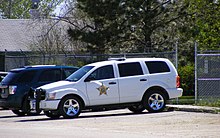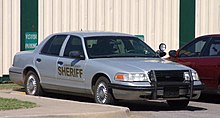Sheriff (United States)
A sheriff is in the United States the head of a police department of a county usually elected every four years by the residents of the county and is.
history
Concept history
In Anglo-Saxon England , the gerefa ( Eng. "Count" or "Greve" ) was a bailiff appointed by the king who had to regulate the public affairs of a place. A high-ranking official, the scīrgerēfa ( Middle English shire-reeve ), was the representative of the royal power in a shire ( ags. Scīr = "county"). Under the Norman kings, especially under Henry I , the sheriff's offices were mostly filled with men of relatively simple origin. They formed the basis for the English landed nobility, the gentry .
The sheriff in the 19th century in the USA
In contrast to the current function of a sheriff, this was formerly the chief administrative officer of a county. Sheriffs were already elected by the people in the 19th century. The tenure then varied from county to county, but was at least a year long.
Often the sheriff was portrayed in Western films as a pure police organ, but this was not the only task. A sheriff was responsible for tax revenue, census, land law (distribution of land or taxation of real estate) and was the enforcement body of the court and / or the county (both criminal and civil).
The purely police duties were carried out by a marshal in the 19th century. The town / city marshal (responsible for a city) was to be distinguished from a US marshal who was subordinate to the state and had executive power over a federal state ( federal court ). The sheriff, by contrast, was empowered to exercise executive power throughout the county.
At that time, a sheriff had his headquarters in the capital of the county (mostly with the County Jail , the district prison). In the towns and villages of a county there was either a Deputy Sheriff or a Town / City Marshal. The sheriff himself traveled to his county at regular intervals to check the individual towns and cities, to collect taxes or to collect the income and, if necessary, to make decisions or provide assistance on questions of property law. He also advised citizens on contractual matters or helped with the authorities.
Tasks, responsibilities and organization
Sheriff's Office
There are sheriff's offices in all states of the United States with the exception of Alaska and Connecticut . In 42 states the sheriff is elected for a four-year term; in New Hampshire and Arkansas only for two years, while in New Jersey he served three years and in Massachusetts six years.
The authority is usually called the Sheriff's Office (also "Sheriff's Department") and is often located in the administrative headquarters of the county. Most of the time, the Sheriff's Office also runs the County Jail ( prison ), where temporary arrests can be carried out, suspected criminals are incarcerated until they are tried or convicted criminals serve their, usually low and under minimum security imposed sentences. Transports of prisoners are usually carried out in the city by the sheriff. There is also a sheriff in New York for these judicial tasks. 911, the emergency number in the USA for police and fire services , is also often answered in the sheriff's offices. Depending on the location and size of the county, a sheriff's office can consist of a single person up to 10,000 employees. There are typically the following positions in a sheriff's office:
- Sheriff - the elected head of the police department, comparable to a police chief.
- Undersheriff - the deputy head of the police department. Undersheriffs are often elected as well, but can also be appointed directly by the sheriff.
- Deputy Sheriff - trained and sworn police officers who carry out police duties on behalf of and on behalf of the sheriff.
- Detention Deputy Sheriff - Deputy Sheriffs who are responsible for running the County Jail.
- Sheriff Coroner death investigators of the Sheriff's Department and the - inquest , to determine the causes of death and related tasks (eg. Death records charge). The coroner can also be its own authority (e.g. Los Angeles County ).
- Dispatchers - officers who answer 911 calls.
Sheriff and police
To understand the difference between the sheriff and other law enforcement agencies in the United States, one can roughly summarize their responsibilities:
- City Police ( Metropolitan Police Department , also veraltend City Marshals or Town Marshals ) - The jurisdiction of the city police ends at the respective city limits. Although police authorities from different cities may work together, they are still independent authorities that act independently of one another. So it happens that u. Small towns with 500 inhabitants may also have their own police force.
- County - The county sheriff's office is responsible for police duties in the respective county, for serious crimes also the district attorney investigators . Since the city police are usually only authorized to carry out police duties within the city limits, the sheriff's office takes on this task outside the city limits. If the city does not have its own city police department, the county sheriff's office is responsible for it within the city limits.
- State Police (depending on the state also Highway Patrol , more rarely also State Patrol ) - Put simply, this refers to the police of the respective state. This is usually responsible for the interests of the state, which is usually limited to the monitoring of highways.
- Federal Police - Are responsible at the federal level, i.e. in all 50 states, for specific, partially overlapping law enforcement tasks in the federal interest (e.g. border security, organized crime , economic offenses , cross-border crime).
equipment
Since a Deputy Sheriff, depending on the size of the county, has to cover long distances - sometimes in rough terrain - different types of vehicles are used for this. The vehicles most used by US authorities in recent years have been the Chevrolet Caprice / Impala and Ford Crown Victoria , as these are already offered ex works with certain authority packages. These vehicles can also usually be seen in corresponding TV series and films. Recently, however, more modern vehicles have also been used, e.g. B. Dodge Charger . Off-road vehicles / SUVs such as B. Ford Expedition , Chevrolet Tahoe or pickups such as Chevrolet Silverado are used; occasionally even sports cars like the Chevrolet Camaro .
Since every police and sheriff's office has a free hand in designing the design of the vehicles, there are sometimes big differences between the respective vehicles. Both the classic black and white scheme can still be found, as well as completely monochrome vehicles that are identified as patrol vehicles by appropriate paintwork or adhesive films. Since the advent of LED technology, the classic light bars on the roof of vehicles have been increasingly replaced by extremely low light bars on the roof or by narrow light bars inside the vehicle (mostly behind the windshield or rear window and behind the radiator grille) - this is being done commonly called "Slick Top". The main reason for this is both the lower price, combined with a longer service life of the lights, lower vehicle consumption (the additional consumption of a Ford Crown Victoria with light bar compared to a structurally identical vehicle without light bar is up to 2-3 liters / 100 km) and higher "Camouflage factor", as the vehicles are not immediately recognizable as police vehicles. They usually have concealed beacons of different designs installed in the vehicle as identification for the application. Are often used front flashers and Dashlights . In the USA, beacons usually flash in blue and red, and also white.
Sheriff star
The seven- point star, which is very common today , was not chosen at random. Each point represents a principle of the sheriff's or police ideology : character, integrity, knowledge, honor, courtesy, loyalty and judgment ; in German: character, integrity, knowledge, honor, courtesy, loyalty and judgment. In some cases, however, five or six-pointed stars are used, while the shield shape is preferred by Police Departments. The US police also see this badge as a symbol of the trust that the population has in them. "The badge is a symbol of trust given to us by the community we serve" ( Commander Mike VanDeutekom, Estes Park Police ).
particularities
In so-called consolidated city counties , the sheriff's office usually coincides with the city police. In New York City, on the other hand, which is the only city in the United States to span several entire counties, there is also a New York City Sheriff's Office for all five counties in addition to the New York City Police Department . However, this sheriff's office only has the task of enforcing civil claims. The prosecuting duty rests only with the NYPD.
Web links
- Detailed explanation of the differences between different police and sheriff departments
- Dominik Nagl: No Part of the Mother Country, But Distinct Dominions. Legal transfer, state formation and governance in England, Massachusetts and South Carolina, 1630 - 1769. LIT, 2013, pp. 127ff., 442ff.
- National Sheriffs' Association
Individual evidence
- ↑ Archived copy ( memento of the original from October 19, 2014 in the Internet Archive ) Info: The archive link was automatically inserted and not yet checked. Please check the original and archive link according to the instructions and then remove this notice.
- ↑ San Diego District Attorney, Bureau of Investigation, District Attorney Investigator Jobs , official website of the San Diego District Attorney, accessed May 12, 2018.





